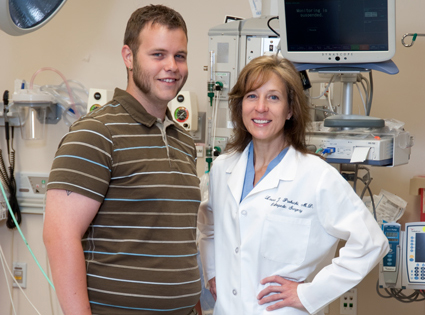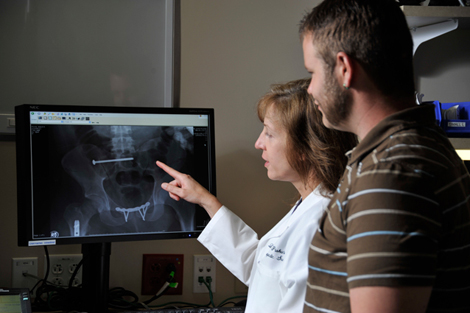Sean Moore was having the worst day of his young life when Orthopedic Trauma Surgeon Laura Prokuski, MD, met him. And that’s saying a lot, because his “worst-day” title had serious competition.

Orthopedic trauma patient Sean Moore and the doctor who put him back together after a motorcycle crash, orthopedic surgeon Laura Prokuski, MD.
“I have history,” he said, somewhat ruefully. “I blew up my car on my 19th birthday; I had my first motorcycle accident on my 20th birthday, and I spent my 21st birthday last year in the ICU.
“I think maybe this year I’ll just reserve a room at the hospital and check in early, before I get hurt!” he said with a laugh.
Explaining his most recent hospital stay, Moore said, “I really don’t remember what happened. They told me I was going through an intersection in the West Valley when a white pickup truck turned right in front of me. I must have seen it and tried to brake; police said there was a 40-foot skid mark behind my bike. My bike and my helmet were trashed.” And Moore was unconscious.
But luckily, Dr. Prokuski was in John C. Lincoln’s Level 1 Trauma Center when Moore arrived, and this doctor was just what he would have ordered, had he been able.
Moore was lucky because orthopedic surgeons are subspecialists. Virtually no orthopedic surgeon will do all varieties of bone and joint surgeries. In today’s medical universe, patients need to connect with the correct medical superspecialist who will treat the specific problem interrupting their lives.
Part of this is because so much more is known today about human anatomy, its problems and how to fix them, and it takes a lot of training to learn everything a surgeon needs to know about fixing any specific bone or joint. So once a surgeon finds a superspecialty that “speaks” to him – or her – it makes sense to focus on that area to the exclusion of everything else.
Moore’s problem was traumatic, and orthopedic trauma was the superspecialty that spoke to Dr. Prokuski when she was a surgical resident. She had started her clinical rotations with no clue what she wanted to choose as a specialty, and she found her first couple of experiences less than thrilling. But her stint with orthopedics started with a trauma patient who was not likely to survive. And the next day, Dr. Prokuski saw the patient up and walking. “It was an epiphany,” she said.
“Seeing this kind of amazing patient progress is the most fun you can have in medicine.”
She likes being part of the Sonoran Orthopedic Trauma Surgeons, Arizona’s only medical group that specializes in trauma orthopedics. “It’s mentally and physically challenging,” she said. “No two surgeries are ever the same.”
"Patients who, like Moore, are having their worst day when they come to you in the Trauma Center can only get better," Dr. Prokuski said, “and they’re really appreciative of whatever you do for them.”
Moore was airlifted to John C. Lincoln’s Level I Trauma Center with a ruptured abdominal aorta and small intestine. John C. Lincoln trauma surgeon Kara Villareal, MD, repaired his aorta and removed about eight inches of his shredded intestine in order to stitch it back together.
Only after his life-threatening injuries were stabilized could Dr. Prokuski do her part. Trauma care is multidisciplinary.
“I like that aspect,” she said. “You can do other kinds of orthopedic surgery as a solo practitioner,” she said, “but in trauma you need lots of other people working with you. You need specialty-trained trauma general surgeons, plastic surgeons, neurosurgeons and vascular surgeons. I like being part of the team.”

Orthopedic trauma surgeon Laura Prokuski, MD, shows her patient, Sean Moore, an X-ray of some of the hardware she installed to hold his shattered pelvis in place.
She repaired Moore’s shattered pelvis, his fractured right femur, a cracked bone in his ankle and three broken foot bones.
Moore thinks he spent several weeks in intensive care before spending the remainder of his two months in the hospital in a medical/surgical unit. But he’s not sure, because most of his ICU time was spent in a medically induced coma.
Youth is an advantage, and, after an extended stay in a skilled nursing facility, Moore was healthy enough to return home, where he was planning to spend his 22nd birthday anywhere but in a hospital.
Moore’s experiences with hospital care have inspired him to work toward a career in the hospital. “I just started school, a program to become a medical laboratory technician,” he said. “I was really inspired by my medical experience.”
For more information, visit JCL.com/orthopedics.